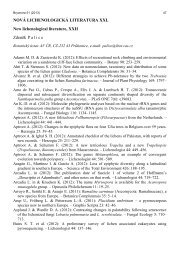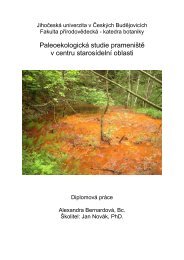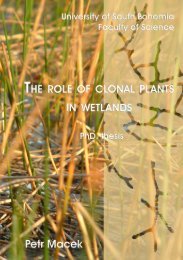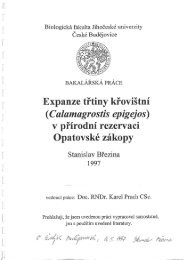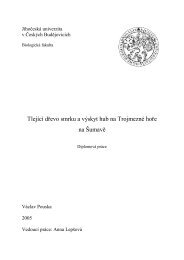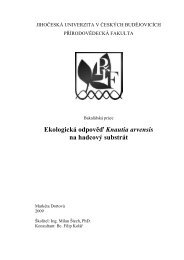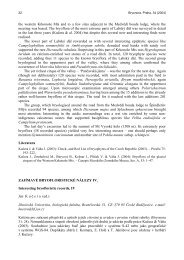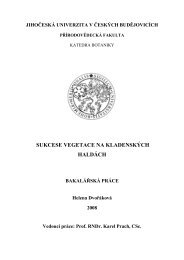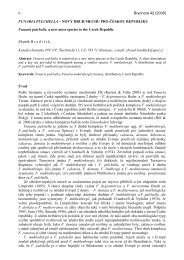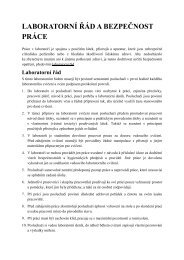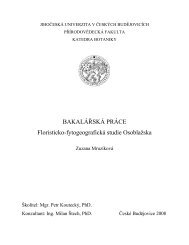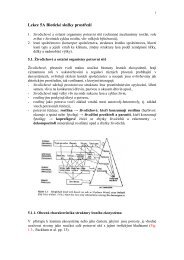Molecular phylogeny and taxonomic revision of chaetophoralean ...
Molecular phylogeny and taxonomic revision of chaetophoralean ...
Molecular phylogeny and taxonomic revision of chaetophoralean ...
You also want an ePaper? Increase the reach of your titles
YUMPU automatically turns print PDFs into web optimized ePapers that Google loves.
2. Summary<br />
The introduction <strong>of</strong> ultrastructural <strong>and</strong> molecular methods clearly revealed that the<br />
original circumscription <strong>of</strong> the order Chaetophorales based on morphological characters<br />
is artificial. Many ‘<strong>chaetophoralean</strong> algae’ fall into various lineages within the<br />
Chlorophyta, <strong>of</strong>ten forming paraphyletic or polyphyletic assemblages <strong>of</strong> the originallyestablished<br />
taxa.<br />
A more refined ordinal concept for the Chaetophorales is defined based on<br />
morphological/ultrastructural <strong>and</strong> molecular characters. Recent studies elucidated the<br />
affiliation <strong>of</strong> the Chaetophorales with the Chlorophyceae, <strong>and</strong> have also shown its<br />
phylogenetic position within this class. Nevertheless, these phylogenetic studies only<br />
dealt with one or two representatives <strong>of</strong> six <strong>chaetophoralean</strong> genera. Therefore the<br />
relationships among the three described families (Schizomeridaceae, Aphanochaetaceae<br />
<strong>and</strong> Chaetophoraceae) remain unknown. The same lack <strong>of</strong> knowledge holds true for the<br />
phylogenetic status <strong>of</strong> the species-rich genera (Chaetophora, Draparnaldia <strong>and</strong><br />
Stigeoclonium) <strong>of</strong> the Chaetophoraceae.<br />
Since most described species (including <strong>chaetophoralean</strong> algae) have been established<br />
solely on the basis <strong>of</strong> morphological characters, many phycologists are now asking the<br />
question: What is the relation between morphospecies, biological species <strong>and</strong> their<br />
phylogenetic position inferred from molecular data? As already recognized, no general<br />
rule can be applied.<br />
Nevertheless, phylogenetic studies <strong>and</strong> crossing experiments revealed that observed<br />
CBC-type substitutions in conserved ITS2 regions are linked to an inability to cross <strong>and</strong><br />
thus may serve as some measure <strong>of</strong> the limits between biological species. Therefore the<br />
CBC ITS2 species concept has become widely applied in algal taxonomy.<br />
However, until now, neither a comparative study <strong>of</strong> the ITS2 secondary structure nor a<br />
relation between CBC ITS2 - clades <strong>and</strong> the <strong>taxonomic</strong> level <strong>of</strong> organisms have been<br />
performed in the green algal order Ulvales. Moreover, the mechanistics by which CBCs<br />
evolve in pairs in the ITS2 region have never been interrogated, nor has the <strong>taxonomic</strong><br />
value <strong>of</strong> non-homoplasious vs. homoplasious CBCs in ITS2 ever been considered. Since<br />
there are many ITS2 sequences available for Ulvalean algae, data from crossing<br />
experiments, <strong>and</strong> morphologically-diverse taxa (previously assigned to the<br />
Chaetophorales) from various habitats, the Ulvales was selected as a suitable taxon to<br />
test the questions posed above.<br />
11



